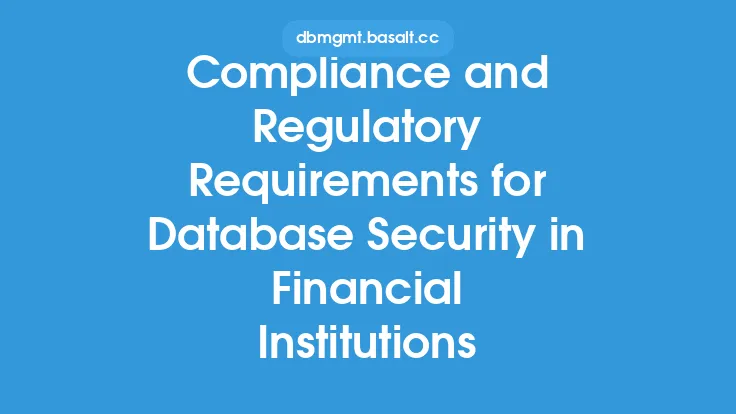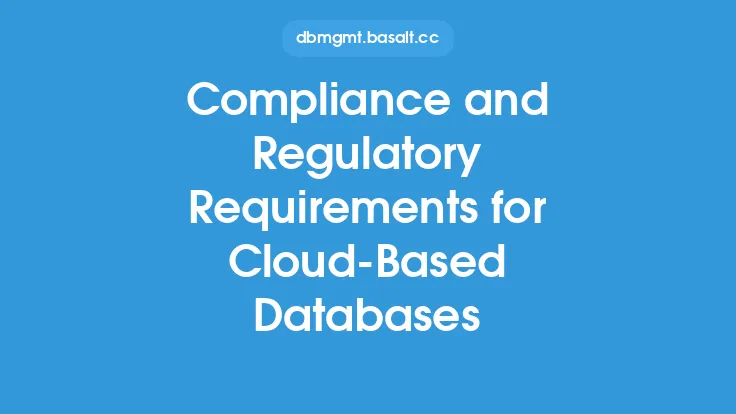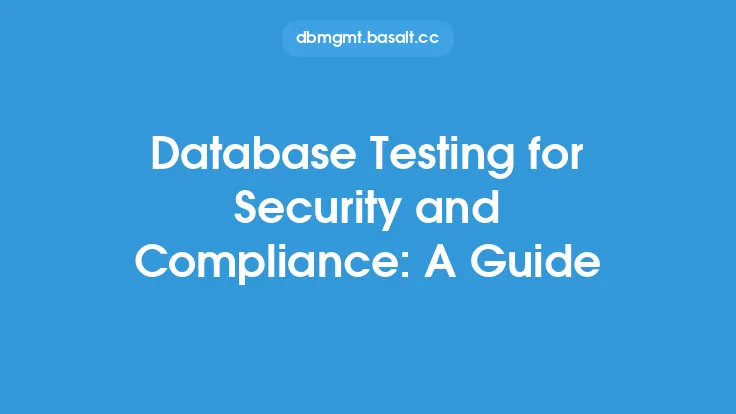Database security is a critical aspect of any organization's overall information security strategy, and compliance with regulatory requirements is a key component of this. In today's digital age, databases are a prime target for cyber attackers, and the consequences of a breach can be severe. As such, it is essential for organizations to understand the compliance and regulatory requirements for database security and to implement measures to ensure the confidentiality, integrity, and availability of their data.
Introduction to Compliance and Regulatory Requirements
Compliance and regulatory requirements for database security are put in place to protect sensitive data from unauthorized access, theft, or damage. These requirements are typically established by government agencies, industry organizations, or other regulatory bodies, and they vary depending on the type of data being stored, the industry or sector in which the organization operates, and the location of the organization. Some common compliance and regulatory requirements for database security include data encryption, access controls, auditing and logging, and incident response planning.
Key Compliance and Regulatory Requirements
There are several key compliance and regulatory requirements that organizations must adhere to when it comes to database security. These include:
- Data encryption: This involves encrypting data both in transit and at rest to prevent unauthorized access.
- Access controls: This includes implementing measures such as authentication, authorization, and accounting (AAA) to control who has access to the database and what actions they can perform.
- Auditing and logging: This involves tracking and recording all access to and changes made to the database, as well as monitoring for suspicious activity.
- Incident response planning: This includes having a plan in place for responding to security incidents, such as data breaches or other types of cyber attacks.
Benefits of Compliance
Compliance with regulatory requirements for database security offers several benefits to organizations. These include:
- Reduced risk of data breaches and other security incidents
- Protection of sensitive data and prevention of unauthorized access
- Improved reputation and trust among customers and partners
- Avoidance of fines and penalties associated with non-compliance
- Improved overall security posture and reduced risk of cyber attacks
Challenges of Compliance
Despite the benefits of compliance, there are also several challenges that organizations may face when it comes to complying with regulatory requirements for database security. These include:
- Complexity of regulations: Compliance requirements can be complex and difficult to understand, making it challenging for organizations to ensure they are meeting all necessary requirements.
- Cost of compliance: Implementing measures to ensure compliance can be costly, particularly for small and medium-sized businesses.
- Limited resources: Organizations may not have the necessary resources, such as personnel or budget, to dedicate to compliance efforts.
- Evolving regulatory landscape: Compliance requirements are constantly evolving, making it challenging for organizations to stay up-to-date and ensure ongoing compliance.
Best Practices for Compliance
To ensure compliance with regulatory requirements for database security, organizations should follow several best practices. These include:
- Conducting regular risk assessments to identify potential vulnerabilities and threats
- Implementing a comprehensive database security strategy that includes measures such as data encryption, access controls, and auditing and logging
- Providing ongoing training and education to personnel on compliance requirements and database security best practices
- Regularly reviewing and updating compliance policies and procedures to ensure they remain effective and relevant
- Engaging with regulatory bodies and industry organizations to stay informed about evolving compliance requirements and best practices.
Tools and Technologies for Compliance
There are several tools and technologies that organizations can use to support compliance with regulatory requirements for database security. These include:
- Database security software: This includes software such as database firewalls, intrusion detection systems, and encryption tools.
- Compliance management software: This includes software such as compliance management platforms, risk management tools, and audit management software.
- Cloud-based services: This includes cloud-based services such as cloud storage, cloud databases, and cloud security services.
- Professional services: This includes professional services such as consulting, auditing, and training.
Conclusion
In conclusion, compliance with regulatory requirements for database security is a critical aspect of any organization's overall information security strategy. By understanding the key compliance and regulatory requirements, benefits, and challenges of compliance, and following best practices for compliance, organizations can ensure the confidentiality, integrity, and availability of their data and protect themselves from the risks associated with non-compliance. Additionally, by leveraging tools and technologies such as database security software, compliance management software, cloud-based services, and professional services, organizations can support their compliance efforts and ensure ongoing compliance with regulatory requirements.





